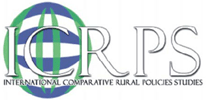Rural Innovation and Field Trip to Moianes
By Alberto Giacometti , Molly Sparhawk, and Neil Stoop
Today was a combination of lectures and field trip activities. The theme of the day was entrepreneurship and innovation. Yancy Vaillant (UAB) was the first to address the group discussing Creative Destruction, and a shift in the innovation regime over time. History has shown a transition from a need to work together with individuals who had ideas, another with technology, and finally another with the capital required. Today all three entities can come together in one individual. He went on to add that innovation is at the intersection of desirability, viability and feasibility. Without all three circumstances innovation cannot happen successfully. Yancy provided further insight outlining that the quality of entrepreneurship is as important as the quantity. He compared innovation happening in Japan to that in Africa. In Japan there are fewer entrepreneurs due to the presence of large corporations, conversely Africa is often driven by need.
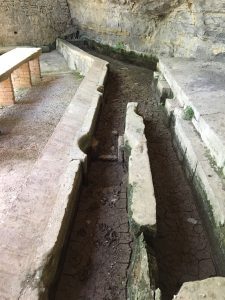
Pre-industrial wool washing facility in the Moaines ecomuseum
Bruno Jean (UQAR) added to the conversation with examples of innovation from rural Quebec. One example he gave was of community members joining together to create a system for fire insurance. He also presented the Universite Rurale Quebecoise (URQ) which was a non-formal education initiative linking academic knowledge with knowledge for the field.
After coffee break we learned about the Community Futures Program in Canada, and the EU’s LEADER program. Community Futures are organizations tasked with funding and providing resources for businesses in local communities. Nearly all rural regions in Canada have access to Community Futures, except for the Yukon. Due to their regional nature they also service some urban communities. Comparatively, the LEADER program is designed only for rural communities. LEADER is a French acronym that translates to “links between the rural economy and development actions”. LEADER is based on several principles including, facilitating innovation, multi-sectoral actions, promoting public-private partners and networking. In order to test our knowledge on the presentations, a Kahoot was done with the class. It is important to remember that team Dinos won the challenge.
The afternoon field trip took us to Moianes, a rural county (comarca) which is the only county with elected representatives in Catalonia. Surprisingly the county received the positive popular vote in 2015 to be established (by merging three counties) in a time where Spain was still facing the effects of the economic crisis, lack of trust in political authorities, and the area had faced the collapse of the textile industry. While surprising, it may be explained by the relative success of the agro industry sector in the region, absorbing the lost jobs from the textile industry. Much of our visit in the region focused on the growing tourist industry. We visited two destinations in the outdoor “eco museum”. The first was a pre industrial wool washing facility fed by a natural stream (see photo above).
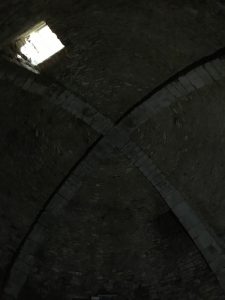
Restored ice well in Moianes ecomuseum
The second stop was at a restored ice well. Ice wells were used to store ice. The ice well is an underground dome, devoid of light save two windows that were used to add and remove ice from the well. The entrepreneurs of the region took advantage of the extreme cold in the 1700’s to make ice that could be sold in nearby Barcelona. We were able to go into the well and take pictures such as the one included here.
After our stops at the outdoor museum, we spoke with local officials including the mayor. Many topics and themes were presented and discussed. In particular two ideas related strongly to rural-urban linkages or lack thereof. The first was that many people, often from urban centres, have second homes in the region. They come to the region as tourists on holidays and on weekends providing a great boost to the community. The biggest draw for tourist in the region is the historic monastery, which is also where the original idea to drain the lake began.
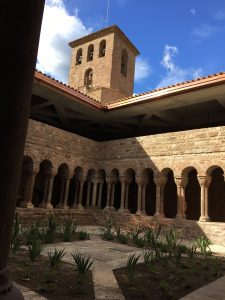
Monastery courtyard in L’Estany
The second topic was about forest management in the area. This example highlighted a deep disconnect between rural and urban individuals. Historically food production took place within the city of Barcelona, and people were connected to the origins of their food. More recently the food production has left the area and come to rural areas, where urban dwellers are unaware of the lifestyle. Part of preserving the farmland in Catalonia is managing the forests to ensure they do not encroach on the agricultural land. The cutting of trees and clearing of land was opposed by urban visitors. This creates problems in rural areas, as unmanaged, growing forests pose a fire threat in the area. They also opposed hunting, until out of control wild pig populations leaked into the city. They also opposed minor events such as ringing bells in the villages. While links are obvious in the tourism industry, it is also obvious that urban populations are unaware of what it means to live and work in rural areas.
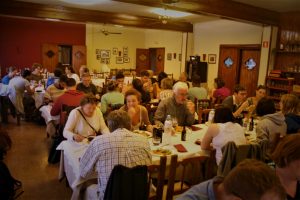
Dinner Hotel Grau L’Estany
The day ended with a wonderful, meat and wine filled meal, at the Hotel Grau a local restaurant as the rain clouds loomed over the village.
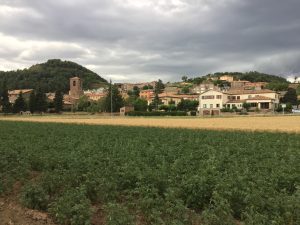
L’Estany village
